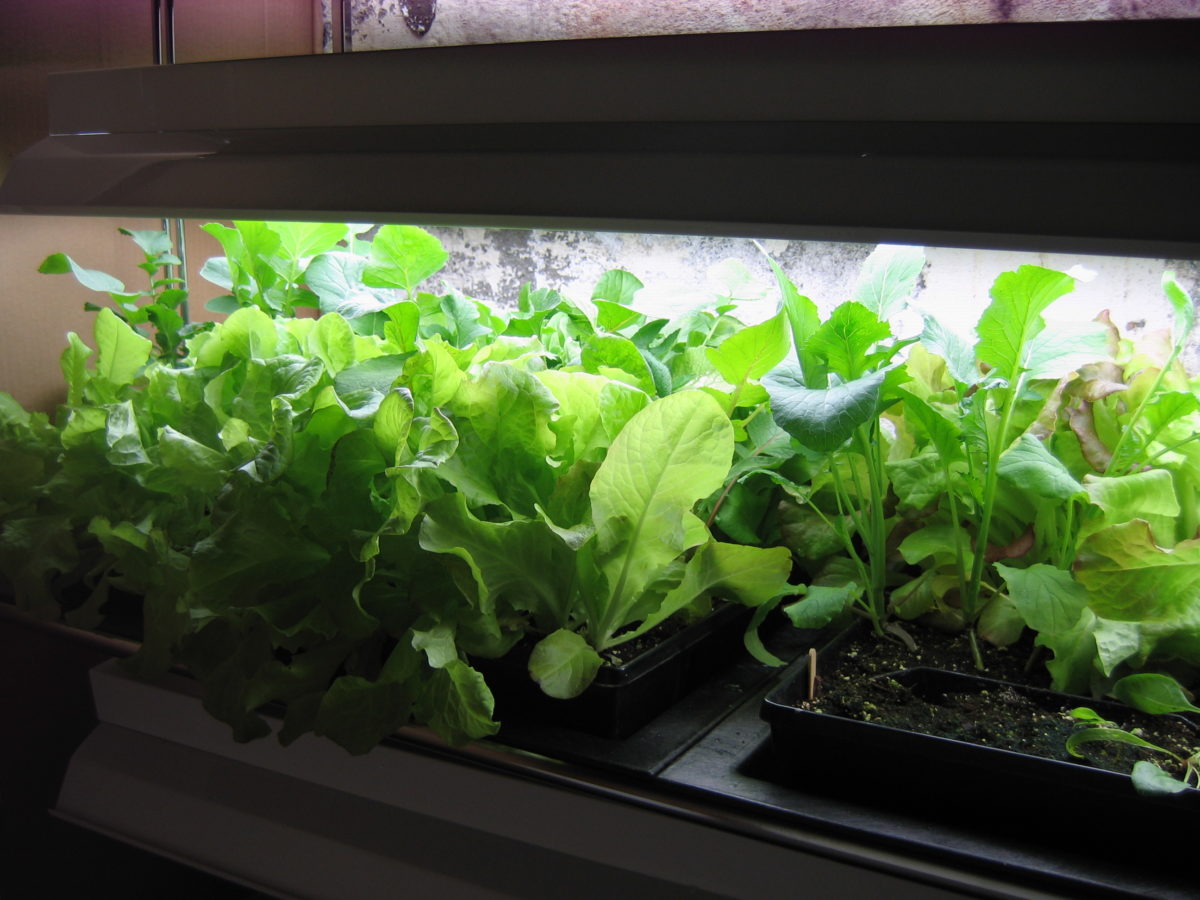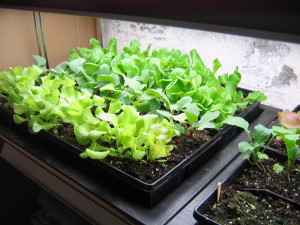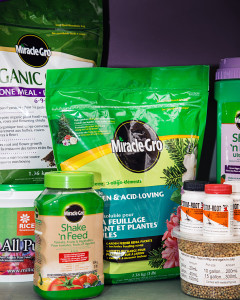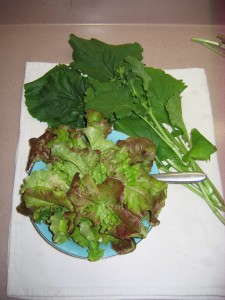
Nothing quite like a fresh salad or greens, crispy and bursting with flavor, straight from your own garden. But it’s really hard to get those when it’s -20C outside and the garden is under a few feet of snow. Right?
Wrong.
You don’t need a lot to grow through the winter. You don’t need a lot of space, and you can still grow without a specialized greenhouse. Without any fuss, special skills, or mess. Let’s look at the basics:
Most of what you need to know you probably learned in elementary school. Plants haven’t really changed, so you’re already a bit of an expert. Pat on the back!
So let’s put all that knowledge to work, and get you some awesome winter lettuce.

What your plants’ needs are:
1) Soil
2) Water
3) Light
That’s it. I’ll touch base on a few additional details, but honest, that’s IT! It does not have to be sunlight, and often some fluorescent lights will give you a lot more control on location, which is important inside 🙂
What you’ll need as supplies for your indoor lettuce garden are:
1) Planting Trays
Some shallow planting trays (I’ve often just used the ones that hold my seedling starters, you’ll see that in the picture above). Lettuce does not need a lot of root space, so giving it more is only wasting your own room and money on all that extra soil. These can be the not-so-pretty trays I use, or they can be absolutely beautiful. Your choice! You can even use clear if you want to see what’s going on beneath the surface (to a small degree, i.e. if there’s water sitting).
2) Potting soil.
I like a good organic mix versus something that is only peat and vermiculite. Your local garden center can help you find this. Do not use soil directly from your yard outside. Sure it works great out there, but outside it has the benefit of the entire ecosystem, including earthworms to keep it loose and from choking the plants. Inside, it is only going to compact and your lettuce will do poorly or even die. Plus, you will be bringing in a lot of undesirable pests or issues that are controlled well outside but not in your happy home.

3) Lights
For lettuce, all that is needed is some full spectrum fluorescent lights. I like to be able to raise and lower mine to keep them as close to the plants as possible, but you don;t have to do this depending on your plant choices. I also use a timer to automate the on-off, but you can get away without one. For things like tomatoes or peppers, which need a bit more photon energy to develop fruits, you can get something more high-intensity like Halide, but don’t go through that expense if all you want is a nice fresh mix of salad greens. If you have a South facing window and want to use that versus the lights, just make sure it gets about 6 hours of daylight minimum, and it not too cold.

4) Plant food (fertilizer)
I do suggest getting some plant food, just a simple, all-purpose 20-20-20 will give what you need, or you can use organic alternatives. As long as there is a little something to give once in a while. Because the plants are in pots and isolated from any other source, they need an occasional pick-me-up. Everything the plants grow for you, they have pulled from the soil, so your lettuce will depend on you to feed them. When you use the fertilizer, you will use it sparingly to avoid building up salts in the soil and around the roots (I often dilute it more than the directions say, so it’s weaker).
5) Seeds
When growing indoors, I have always started from seed. In the north, it’s very hard to get seedlings past July (read: impossible) and so you may find you fall in love with seed catalogs.
6) Location
This is really up to you. Do you want to enjoy seeing the plants while you go about your daily routine, or do you want them out of the way, perhape because of pets or small children? When choosing your space, keep in mind if it’s not warm enough the seeds will not germinate, or growth will be slow. If you do have a cooler spot, you may find it a benefit to invest in a heat mat. Typically you don’t need a heat mat for cool crops like lettuce, spinach, kale, etc. I have had plenty of luck on those salad crops without one. Two more things to consider – drafts or furnace vents. One will chill your plants too much and could kill them, one may dry them out regardless of how much you water them.
So what should you grow in your indoor salad garden?
I’ll list a few good starting items, but always be creative with what you try! What works well for me may not be your ideal. When trying different things, keep in mind the light available (tomatoes need higher intensity for fruiting but do great if only being seed-started for your summer garden outside), temperature (some things like heat, some can’t stand it), and space for the roots (ie, broccoli needs more root space than a shallow tray)

Excellent things to start with:
Lettuce!!
I’ve had much more luck with leaf varities than head varities inside. I just pick individual leaves as I need or want them and let the plant continue to produce as long as possible. I suggest sowing some seeds, and sowing more every two weeks to keep a good supply through the winter. It takes about a month for these to be ready to eat, so start them in the late fall if you want no interruption from your gardens outside. (here in Thunder Bay, Ontario I would start them mid-late August).
Arugula
This is a great grower, adds great flavor to your salads, and is perfectly happy in the cold. Grow arugulas like lettuce, but give them a bit more space between the plants
Radishes
I’ve had good luck with radishes, as long as the soil does not get warm (makes them bolt). Have a cool windowsill? Try them there, see how they do 🙂 You may have to germinate the seeds a bit warmer and move them, but every home is different.
Herbs
I can’t see why you would skip these if you have the space 🙂 They do not need a lot of root space, and are quite happy under the fluorescent lights since they do not fruit. Try some, see what they do.
Sprouts
The easiest and fastest salad green you can grow indoors, and they make a good option to change your salad up with versus the same old part-way through the season. You can even grow these on your kitchen counter on wet towels. For these, try visiting Sprouting.com
Kale, Broccoli Raab and Cabbage
You can grow these inside, they do need a bit more root depth and space between plants, so I’d do them if you have the room, but stick to lettuces if you don’t. They also take longer to grow, but if you space out your plantings they can add a nice alternative in your mixes.
And really, you are now ready to grow your own fresh greens all winter. In the next post “Interior Design with Salad Gardens” you’ll find some really really great options to make your indoor salad garden an enjoyable part of your living space (did I say pretty?), or you can browse some on my Pinterest board for indoor gardening.
If you have more questions, please ask 🙂 Happy to help if I can.

Did you end up making a fresh salad for holiday dinner this year from the greenhouse?
I did! I actually had WAY more than enough greens, even with only harvesting Arugula and some of the bolted leaf lettuce. And it was TOTALLY worth it. YUM!
Pictures on Facebook 🙂
Hey, I see you have a Twitter page, do you tweet all your new blog posts?
Hi Kelsee,
Yup. I tweet them when they are published, or people can subscribe for an email notification when new posts are made.
Are you planting the lettuce in a soil filled try or are they in those plastic seed starter inserts?
These are in a flat tray 🙂 No need for inserts when growing this way.